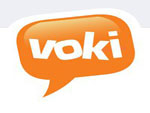At a Glance
What is it?
Website
Voki

Voki allows users to create personalized speaking avatars and use them to re-create historical actors, unique characters, or other figures. By controlling their voices, students can use their avatars for role play or to reenact famous speeches.
Getting Started
Luckily Voki allows users to practice creating an avatar without enrolling or creating a new account. You can choose characters from various categories and several obvious historical personas are available like George Washington, Abraham Lincoln, and modern-day political figures. Each avatar can be customized by head, clothing, accessories, and various voice options. Users can also select background images and resize the avatar in relation to the player window. After selecting the voice option, users can enter text and listen to the voice that is created. Likewise, if users want to record their own voice they can also playback their recording until satisfied.
Once the Voki avatar is created, users can publish their creation. By registering an account with Voki, all Avatar creations are saved under the user's account for continual access. If users forego the registrations, the finalized avatar does contain a unique URL link (which should be copied down for later access.) Users can also use the embed code to immediately post or bookmark the avatar in whichever social network site they prefer.
Whether users want to embed their avatar on their own site, in an email, or a course blog, these creations can liven up any history class.
Examples
In a simple avatar that imagines a modern-day George Washington, students could apply Washington's guiding philosophies to modern issues such as health care, immigration, or foreign interventions. By speaking through an avatar, students will not only retain online privacy (great for teachers and parents!) but will appreciate an innovative and safe platform for classroom presentations.
Students can use their avatars to engage in debates and topic discussions—such as Abraham Lincoln and Ronald Reagan engaging in issues of states rights and federalism. Likewise, students could use their avatar creations to address a homework question on a course blog or wiki page. Another good use of Voki avatars is to re-enact famous speeches such as the Gettysburg Address, or to summarize the President's State of the Union Speech in under two minutes by examining word clouds released after the speech.
Finally, a wonderful use for these avatars is to apply gained knowledge of philosophical views of historical figures into fictional scenarios. For example, students can create a fictional character that meets a certain demographic (i.e. middle-aged Hispanic female nurse). Then the entire class, made up of various American citizens, can conduct a town hall debate on the key issues of the past and present. A variation of this format is to conduct a town hall of famous American politicians and personalities—such as Barack Obama, Reagan, Washington, Lincoln, John Kerry, Hillary Clinton, Sarah Palin, and John Stewart.
For more information
Voki for Education has plenty of materials and suggestions that can help teachers gain inspiration for how to make the best use of the available technology. One helpful feature is the Teacher's Corner Message Forum—a quick browse through the posted messages is worth the time spent.
Voki also has a Lesson Plan site that can be searched through grade level and/or subject area. A useful FAQ section can also help users to orient themselves to the tool.